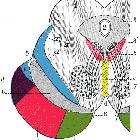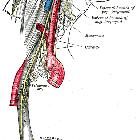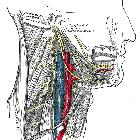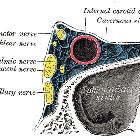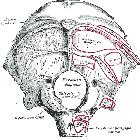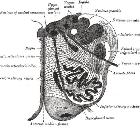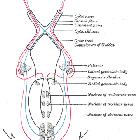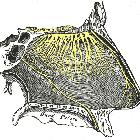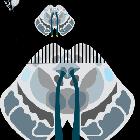cranial nerve
 siehe auch
siehe auchPons
Medulla oblongata
Nervus olfactorius
Nervus facialis
Mesencephalon
Nervus vestibulocochlearis
Anatomie Hirnstamm
Nervus opticus
Nervus glossopharyngeus
Nervus oculomotorius
Nervus abducens
Foramina der Schädelbasis
Nervus hypoglossus
Tegmentum (Gehirn)
Nervus vagus
Nervus accessorius
Nervus terminalis
Nervus trochlearis
Hirnnerven Eselsbrücke
The cranial nerves are the 12 paired sets of nerves that arise from the cerebrum or brainstem and leave the central nervous system through cranial foramina rather than through the spine. The cranial nerves are numbered one to twelve, always using the Roman numerals, I to XII. Most have cranial nerve nuclei located in the brainstem.
Cerebrum
The first and second cranial nerves derive from the telencephalon and diencephalon respectively and are considered extensions of the central nervous system:
Midbrain
The third and fourth cranial nerves originate from the midbrain:
Pons
The middle four cranial nerves originate from the pons:
- trigeminal nerve (CN V)
- abducens nerve (CN VI)
- facial nerve (CN VII)
- vestibulocochlear nerve (CN VIII)
Medulla oblongata
The final four cranial nerves originate from the medulla oblongata:
- glossopharyngeal nerve (CN IX)
- vagus nerve (CN X)
- accessory nerve (CN XI)
- hypoglossal nerve (CN XII)
In adults, the brainstem nuclei are located within the tegmentum, the posterior section of the brainstem (except in the midbrain where the quadrigeminal plate is most posterior).
See mnemonic for cranial nerves.
History and etymology
Thomas Willis (1621–1675) was responsible for the original numbering of the cranial nerves, as well as his famous anatomical circle in the brain.
Siehe auch:
- Nervus trigeminus
- Pons
- Medulla oblongata
- Nervus olfactorius
- Nervus facialis
- Mesencephalon
- Nervus vestibulocochlearis
- Anatomie Hirnstamm
- Nervus opticus
- Nervus glossopharyngeus
- Nervus oculomotorius
- Nervus abducens
- Foramina der Schädelbasis
- Nervus hypoglossus
- Tegmentum (Gehirn)
- Nervus vagus
- Nervus accessorius
- Nervus terminalis
- Nervus trochlearis
- Hirnnerven Eselsbrücke
und weiter:
 Assoziationen und Differentialdiagnosen zu Hirnnerven:
Assoziationen und Differentialdiagnosen zu Hirnnerven:





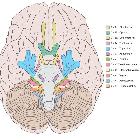


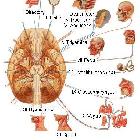



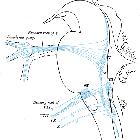







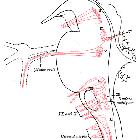

 ähnliche Suchen
ähnliche Suchen

